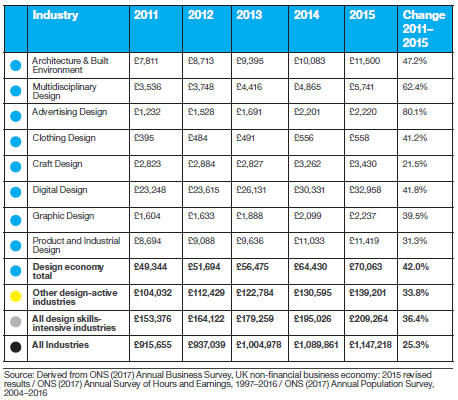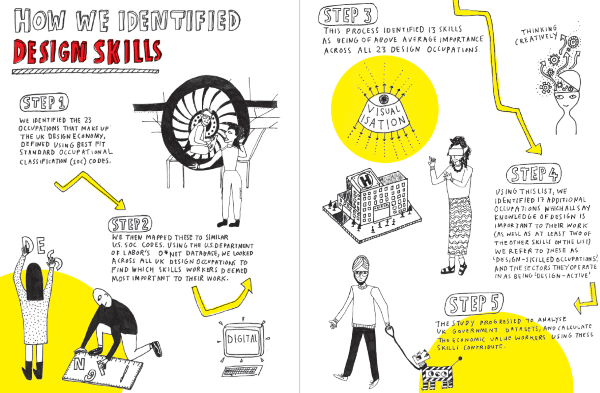About the research
As the UK is planning its exit from the European Union,stagnant productivity and growing automation are also putting pressure on living standards and job security of UK citizens.
This study builds upon the Design Council’s 2015 Design Economy study which presented a comprehensive analysis of the value that design adds to the UK economy, finding that design workers (those workers which use design skills as identified during research) are considerably more productive than the average UK worker. This piece of research examines the skills that differentiate design from other sectors in the UK economy and explores the value created by those employed in design roles across a variety of industries,including those not always associated with design, such as automotive or financial companies. The study combines UK and US data to investigate the relationship between design skills and economic outcomes, focusing on productivity and innovation.
The aim of this study is to investigate the skills used within the design economy, the link between skills and productivity and innovation,and how they align with future demand for skills across the wider UK economy.To aid in their research, Design Council commissioned Ortus Economic Research to undertake this study with four main research objectives:
- To understand the skills associated with design occupations
- To describe the value of design skills to the UK economy
- To investigate the demands and supply of design skills
- To describe key labour market characteristic of the design economy
The research shows that design skills are more widely used than previously thought; workers contribute £209bn to the UK economy (GVA);people who use design skills are 47% more productive than the average UK worker, delivering almost £10 extra per hour; and at least 2.5m people use design skills in their day-to-day work (equivalent to 8% of workers). The research also finds that there is an ever-growing skills gap, with one in eight employers stating that their employees are not fully proficient in their current jobs, and estimating that this costs the UK economy £5.9bn a year.
The key findings allow the Design Council to produce recommendations. These are:
- moving from STEM (Science, Technology, Engineering and Maths) to STEAMD (Science, Technology, Art, Maths and Design skills);
- education providers and regulators to embed design in the curriculum;
- greater support and resource for lifelong learning; recognition and inclusion of design in the implementation of the industrial strategy;
- and promoting greater use of design in parts of the economy most in need of a boost.
Upon publication, the key findings were reported on by www.designweek.co.uk and also appeared in their latter feature on ‘5 important things that happened in design this week’, with a quote from Sarah Weir, Chief Executive at Design Council stating that “Design is all around us – in our homes, our offices, our travel networks and even our health and education systems. But it is precisely because design is at the centre of our lives… that its value is often overlooked.”
Methodology
Multiple data sets were used during analysis, including Office for National Statistics (ONS) data sets Annual Survey of Hours and Earnings(ASHE), Annual Population Survey (APS) and UK Innovation Survey; all accessed via the ONS Secure Research Service (SRS). In addition to this, open data sources were also used, including the U.S. Department of Labor, Employment and Training Administration (2016) O*NET 21.0 Database.
The methodology employed was designed to reflect and build on that used in the Design Economy research.
The Design Council used the US Department of Labor’s O*NET database as a source of information on defining the skills used in design roles under the assumption that the US skills profile is a suitable stand-in for the UK. By mapping the UK Standard Occupational Classification (SOC) to US SOC, the Design Economy’s definition of design occupations has been employed to identify the most important skills associated with design occupations.
Using ratings of importance, Design Council created an index score (or ‘Importance Premium’)which helped identify skills which were deemed by designers to be of above average importance for their role (compared to what might be expected across the whole workforce). This list was then extrapolated to identify other occupations elsewhere across the UK economy which also report having ‘knowledge of design’ as an important skill for their work, as well as at least two other skills from the list of 13. A total of 17 other occupations were identified and referred to as ‘Design skilled occupations’.
With this framework in place, the study went on to utilise a wide range of economic and labour market data sets, predominantly the ASHE, APS and UK Innovation Survey, to investigate key research questions at outlined within the summary.
Findings for policy
The findings of the report are structured into threesections: skills used by designers; value of design skills to the UK economy;and acquisition and development. Key findings from each are outlined below.
Skills used for design:
- Design delivers 21st century skills. Designers use a wide range of skills in their work. This combination of technical skills, cognitive abilities and interpersonal competencies will become more and more essential in the future.
- Design skills are used across the economy, not just in design firms. Seventeen additional occupations were found outside of the design economy that uses the same intensive design skills.
- Design skills are highly connected to innovation; 1 in 4 of the occupations that identified as reporting substantial use of design, also have high innovation skills intensity.
The value of design skills to the UK economy:
- Design skills are highly valuable; workers with design skills contribute £209bn to the UK economy (GVA)
- Design skills drive higher productivity; people who use design skills are 47% more productive than the average UK worker, delivering almost £10 extra per hour
- Design skills not confined just to design sectors; at least 2.5m people use design skills in their day-to-day work (equivalent to one in 12 workers, 8%)

Skills acquisition and development:
- Design skills gaps amongst existing workforce; an estimated 59,000 people working in design skills-intensive industries have skills gaps
- Existing design skills gaps costs the UK approximately £5.9bn per year
- Pipeline of future designers narrowing; in 2017 just under 166,000 GCSE students took Design and Technology subjects, a 61% decrease from the year 2000
Impact
Designing a Future Economy is a unique report, cataloguing the skills which are intricately connected to design and innovation. The report highlights that these skills are essential for any economy seeking to maximise the opportunities of technological advancements. However, alongside these opportunities come significant challenges.
The report demonstrates that the UK has skills gaps and shortages in design and a narrowing pipeline of young designers who could otherwise fill these roles. Firms are also not providing the level of additional training required after formal education. In response, the Design Council have produced 5 key recommendations:
Education providers and regulators embed design in the curriculum. Traditional pathways into design careers are being eroded. The Department for Educations, schools and academies should re-introduce GCSE Design and Technology as a priority subject in post-14 education.
Moving from STEM to STEAMD. Boosting STEM (science, Technology, Engineering and Maths) and digital skills alone will not suffice. Along with Art, design methods, tools and approaches should be incorporated in STEM subjects to boost skills required in the future economy.
Greater support and resource for lifelong learning. A government strategy is necessary in addressing the existing skills gaps whilst anticipating the future skills needed. Investment in career long learning with access to resources, training and non-formal education are required to equip people with higher value skills for future work.
Recognition and inclusion of design in the implementation of the industrial strategy. The Design Council note that designers use their skills to develop a deeper understanding of people’s needs. An industrial strategy utilising these skills and principles is more likely to succeed and positively impact upon people’s lives.
Promoting greater use of design in parts of the economy most in need of a boost. Businesses, the design industry and the Government should explore what incentives could be used to encourage greater use of, and upskilling in, design across key areas of the economy; particularly targeting those sectors with the lowest levels of productivity and highest changes of automation.
To capitalise on economic and technological change, bold policy solutions are needed. It is essential that Government and industry work together to ensure that Design and innovation are at the heart of industrial, skills and economic strategies.
Read the Report
https://www.designcouncil.org.uk/resources/report/designing-future-economy-report



Data used in this case study are also available from the UK Data Service:

